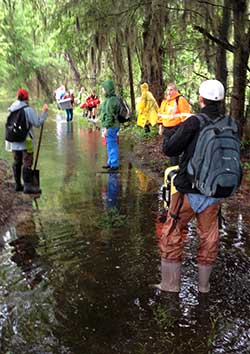Uncovering the Past: UWG Field School Explores the Rich Prehistory of Savannah River Swamps
by Justin R. Unterwagner
This past June, I was fortunate enough to be one of twelve anthropology students from the University of West Georgia (UWG) to take part in an archaeological field school under the guidance of professors Dr. Ashley Smallwood and Dr. Thomas Jennings. We spent four weeks excavating one-by-one meter test units in the dense swamps of along the Savannah River. Each morning our group set out on a one-mile hike to the site, crossing creeks and often wading through knee-deep murky water, avoiding snakes and alligators along the way.
 The site remained hidden for thousands of years until Georgia Department of Transportation (GDOT) archaeologists surveyed the area during the mid-1970s. GDOT’s initial site surveys were conducted by Southeastern Archaeological Services (SAS) under contract for the GDOT. As a result of the site survey, SAS was able to locate stratified deposits of archaeological material within a relict sand ridge. Further investigation was deemed necessary, so the area was preserved and protected.
The site remained hidden for thousands of years until Georgia Department of Transportation (GDOT) archaeologists surveyed the area during the mid-1970s. GDOT’s initial site surveys were conducted by Southeastern Archaeological Services (SAS) under contract for the GDOT. As a result of the site survey, SAS was able to locate stratified deposits of archaeological material within a relict sand ridge. Further investigation was deemed necessary, so the area was preserved and protected.
With the permission of GDOT and the Georgia Department of Natural Resources (GDNR), UWG returned. The goal of the initial field school was to begin full-scale block excavations to better understand the prehistoric occupation. After establishing a site grid with fixed points to help us monitor the horizontal and vertical location of artifacts, we carefully hand excavated by trowel one-by-one meter test units, five-cm layers at a time. The sediments troweled away from the surface were screened through ⅛” mesh to catch tiny pieces of flaked stone and plant materials like charred hickory nuts. During the excavation, we paid careful attention to any noticeable changes in sediment color, texture, and composition.
As we dug down, we tried to keep all artifacts in situ, their original position in prehistory; the provenience, the exact vertical and horizontal location, of all artifacts was recorded; and a digital photo was taken to document the artifacts in place before their removal. In teams of two, we collectively excavated a total of six one-by-one meter units. Just in those six excavation units, we found seven diagnostic artifacts, artifacts that are key to understanding the American Indian populations that occupied the site, that tell us that the site was occupied approximately 7,000-4,000 years ago.
Through our initial findings, the site is believed to be the location of a seasonal prehistoric hunting camp where stone was carried in from nearby locations. We hope to do additional work to expand the excavation blocks and explore evidence of an occupation older than 7,000 years ago.
In closing, I thank everyone involved, for making this field school--an invaluable experience that I will never forget—possible. I would like to extend special thanks to Dr. Smallwood and Dr. Jennings; both were a pleasure to work with. Their level of enthusiasm towards this project was evident from the start. Thanks also goes out to the UWG, GDOT, and GDNR for their invaluable support.
